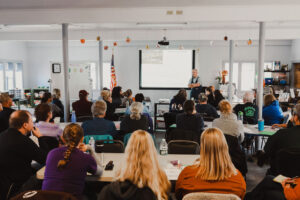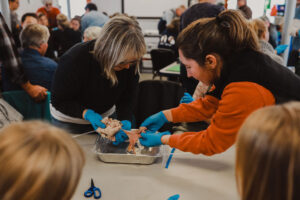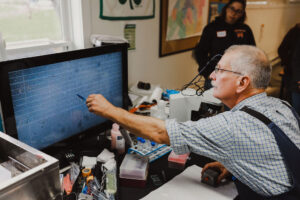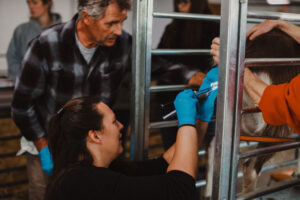Final report for ONE19-337
Project Information
A series of 11 videos featuring all aspects of goat artificial insemination were created between October 2019 and May 2021. The project started with a hands-on workshop that reached 40 farmers. Four people, Betsy Hodge, Cornell Cooperative Extension - St. Lawrence County, James Weber, University of Maine, tatiana Stanton, Cornell University and Rene' DeLeeuw, goat reproduction consultant, worked together on the project.
The workshop topics were recorded later on Zoom after dividing them up into shorter segments. Videographers added clips and pictures from the program, removed barking dogs in the background, and added a consistent beginning and ending. These videos will be posted on-line at CCE of St. Lawrence County (http://stlawrence.cce.cornell.edu) the Cornell goat reproduction page ( https://blogs.cornell.edu/smallruminantdairy/herd-management/reproduction/) and the University of Maine Extension page. The videos are posted on You Tube and can be found by searching our names or goat AI (and the links are posted in the full report). Corresponding handouts will be posted as well (they are uploaded in the full report).
It is our hope that these videos will provide a background for goat farmers unable to attend in person trainings. They may also be used by Extension educators in educational programs for goat farmers or educator trainings.
The video titles are:
Video 1 - Introduction and Why AI?
Video 2 - Goat Reproductive Anatomy and Semen Handling
Video 3 - Synchronizing and the Timing of AI
Video 4 - Managing Your Does and Bucks for Successful Breeding
Video 5 - Choosing a Buck - Part 1 - Selection Criteria and Methods
Video 6 - Choosing a Buck - Part 2 - Dairy Goat Genetic Evaluations Available in the USA
Video 7 - Choosing a Buck - Part 3 - Other Performance Evaluations
Video 8 - Choosing a Buck - Part 4 - What's in our Future - Genomics
Video 9 - The Mechanics of Goat AI
Video 10 -Equipment Basics for Goat AI
Video 11 - An Introduction to Buck Collection
If you are thinking of undertaking a project with a live component and a video follow-up we recommend you read our suggestions at the end of the full report.
This project seeks to demonstrate goat artificial insemination at a hands-on program in the fall of 2019 and while we have all the instructors together to create teaching materials that will be useful to Extension Professionals and farmers.
Developed materials would include short webinar style lectures on topics like semen selection, semen handling and quality, the reproductive system of the doe, the reproductive system of the buck, different synchronization techniques and when to use them, the equipment you need to do AI at your farm and others. Videos of actual artificial insemination with shots from inside the speculum, sperm under the microscope, and other details will be professionally filmed while the instructors are all in one place for the program. The videographer will edit the roll into educational videos with guidance from the collaborators.
Videos will be posted and available to the public by September of 2021.
Program Objectives:
1. To gain a basic understanding of genetics and the heritability of traits so as to make wise selection decisions
and the use of sires and dams.
2. To understand the importance of the setting and implementing culling standards and culling individual animals
for overall flock/herd improvement.
3. To understand the anatomy and functions of the reproductive tract of sheep and goats; learn livestock
reproductive terminology, influences on the system, common problems, and breeding basics such as sexual
maturity, estrus and heat cycles.
4. To understand the application of simple management techniques for optimum performance of males and
females (health, nutrition, maturity, day length, weather, stress, markets, etc.).
5. To understand the process of natural breeding, fetal development and birth.
6. To understand the pros and cons of artificial insemination techniques and how AI could be used in their
operation.
7. To learn about acquiring semen from within the US and internationally, including understanding regulations and
the process of importation.
8. To learn how semen is collected and evaluated for use under a microscope.
Goal: Participants will learn and apply proper techniques to artificially inseminate goats.
Hands-On Training Session Objectives:
1. To understand the importance of biosecurity and how it applies to breeding and animal/semen handling.
2. To understand proper handling of animals and semen for breeding artificially.
3. To learn about the equipment and supplies needed for AI.
4. To learn how semen is evaluated under a microscope (viability, sperm count, etc.)
5. To understand how does are brought into estrus and the use of controlled internal drug-releasing devices
(CIDR).
6. To artificially inseminate a doe and to build skills in successful insemination practices.
7. To appreciate proper record keeping of reproduction data.
8. To learn how to evaluate breeding procedures and outcomes.
The problem is that there are few videos or training materials developed by Extension personnel for teaching goat
artificial insemination. Larger commercial farms have trouble attending meetings that aren’t nearby. It would be
advantageous to Extension educators to have a set of lectures recorded and some professional videos to show at
workshops on farm or in the classroom.
Artificial insemination allows large and small producers to take advantage of better genetics to improve their
herds’ output of meat, milk or fiber and avoid the bio-security issues of bringing in new bucks. Most producers are
aware of the advantages of artificial insemination but don’t know how to do it or have the equipment to do it.
Goats numbers are limited compared to cattle so bucks that are unrelated can be challenging to find or require
traveling long distance travel to purchase them. Using artificial insemination would allow farmers to have more
choices for genetics.
Extension educators running AI classes have a limited selection of videos to choose from. The videos available
on-line tend to be home-made or not in English. Some of them are questionable in their techniques. There are
videos produced by agribusinesses with products on the market that would not be appropriate for an Extension
educational program.
A large survey of livestock producers in New York, including a series of meetings to determine priorities from
producers concluded that producers are requesting more advanced Extension materials which this program and
the videos would provide. Artificial Insemination presentations at the Cornell Sheep and Goat Symposium are
always full which shows the demand for more programs and materials in this subject area.
A review of what we could find on-line for videos revealed that there are videos but not the type we are planning
to create. They are either not correct in their instructions, poorly made, in another language, or from an
agribusiness with products on the market.
BIO-Genics, LTD offers a course for about $1000 where they will come to your farm or program location and
teach you goat AI hands-on if you provide the goats to breed.
www.biogenicsltd.com
Addition searches on-line did not find any instructional information or videos offered from any of the Land Grant
universities that normally support goat production (Langston, Cornell, Penn State, Maryland, etc). There is
information in articles and factsheets but no videos to watch or recorded lectures of the type we are going to
make.
We will produce a series of short lectures done in a webinar style with pictures and speaking that will be loaded to
You Tube or other easily accessed site. Videos of hands on actual AI insemination with additional resources,
diagrams and pictures edited in, will be created and posted at the same sites. These will be available for farmers
to use directly and for Extension Educators to use for educational programs
Cooperators
- (Educator)
- (Educator)
- (Educator)
Research
2019 PROJECT ACTIVITIES
We have met the objective of holding an educational workshop about Goat AI and having videographers present to film parts of the workshop.
- We held the Goat AI Workshop October 4 and 5, 2019.
Saturday the 4th was goat artificial insemination and Sunday the 5th was buck collecting and semen processing.
• We anticipated 15 participants for Saturday and five for Sunday and ended up cutting it off at 40 on Saturday and 15 on Sunday.
• Students attended from Pennsylvania, New York, New Hampshire, Maine, Vermont and Ontario, Canada.
• Several producers brought does to breed on Saturday and one producer brought bucks for us to collect.
• Videographers were filming both days to provide footage for the videos to be produced.
• Prior to the program we successfully synchronized 20 does and managed to get the semen in our tank and get the tank delivered to the farm. Some of the does were synchronized at their home farm.
Saturday October 4th
9:30am - Intros and Why AI?
– Dr. James Weber, U Maine
9:45am - Reproductive Physiology
– Dr. James Weber, U Maine
In addition to the lecture there was a sheep reproductive tract on each table for participants to dissect. We also gave them breeding guns to work with the tract.
11:00am - Managing Does and Bucks for Successful Breeding
– tatiana Stanton, Cornell and Rene Deleewe
In addition to the lecture we went into the barn and Rene Deleewe went over an animal and talked about traits to select for and why. James Weber did a mucus check to talk about how to tell if the goat is ready to breed.
12:30pm – LUNCH
1:15pm – AI - How to use it on Your Farm
– James Weber, Rene DeLeewe
In addition to the lecture we had equipment and synchronizing items to show and pass around. Rene DeLeewe talked about how to get semen to your farm and store it as well.
2:15pm – AI – How do you do it?
- Rene Deleewe and James Weber
A demonstration of actual semen thawing and insemination. Looking at semen under the microscope. Watching Rene and Jim do inseminations on Extension goats.
All participants were able to try inseminating the goats. Many were using real semen. Jim was in the other room handing out semen and breeding guns and the rest of the instructors and farm help were in the barn wrangling the goats onto the stands.
We finished about 6:00 pm and many of us went to dinner together and continued our goat conversations.
Sunday October 5th -
9:00am-12:00pm – Nuts and Bolts of Buck Collection/Semen Evaluation and Processing
James Weber
Several people were able to collect the bucks brought by Diana Walters. James Weber demonstrated how to take the semen and count it and extend it and put it into straws. He also talked about the freezing process. Many more people were interested in this process that we expected.
We had found some money in another grant to compensate the local small ruminant vet to attend but she decided she did not need compensation for the event because it was so interesting!
The next step is to record the lectures on Zoom and get them to the videographers to make into educational videos.
FROM ORIGINAL PROPOSAL:
Four professionals plus three farmers will work together to plan a goat AI program for the fall of 2019 to take place
in Canton, NY at the Cornell Cooperative Extension Learning Farm. Betsy Hodge, CCE Livestock Educator,
tatiana Stanton, Cornell University Extension Associate, James Weber, Phd, DVM, University of Maine, and Rene
DeLeeuw, experienced goat genetics manager will design and present a program for goat owners and managers
to learn the basics of artificial insemination. Blake Place, Hidden Pastures Dairy, Rhonda Butler, Asgaard Farm
and Pete Snyder, President of the NY Dairy Goat Asoociation will give their input as well.
While the instructors are all together for the weekend they will create video footage that can be made into specific
training videos by a professional editor after the program. Lectures will be refined and then recorded with the
power point and voice and also provided as videos that could be used together or as separate topics. All of the
materials will be posted at the Cornell Goat Extension site and the University of Maine Extension site.
The Extension Learning Farm is a good place to hold the program because we have goats that can be used for
the demonstration, a lab with AI equipment for processing semen, heated stand microscope, water bath,
collecting equipment, semen tank, etc. We can also house additional goats for the program like bucks to collect
and other does to use for practice.
Videos will be made available free of charge to those wanting to use them as training for farmers or farm
managers.
The goal will be to have it all done and posted on-line by the end of one year and hopefully sooner.
The purpose of the 2-session seminar is to equip both sheep and goat producers with practical knowledge and
skills related to small ruminant reproduction and artificial insemination. From this they can utilize these
management tools in their respective enterprises obtaining noticeable improvements in their livestock and
financial bottom line.
We are proposing a two day session for producers interested in learning to do AI. The first day will be lecture
activities in the morning and early afternoon and hands on goat breeding in the afternoon. The second day will be
for those interested in more in depth semen collecting, handling and freezing. Proposed dates are September 28
and 29 or October 5 and 6, 2019 (Actual dates were October 4 and 5, 2019)
Evaluations from AI training workshops:
19 evaluations were filled out (about the number of different farms that attended).
When asked about whether the topics were Not relevant (1) to Important (5) the ratings were very good
Repro Phys – 4.73
Managing – 4.5
How to use AI – 4.73
AI Demo – 5
Hands on – 5
All answered that they want to try AI breeding next year and some were even going to try it this year.
Barriers to AI – Participants mentioned time, start-up costs and a good place to do it with help as barriers to doing AI at their farm. Several mentioned that they just needed to learn more about it before they tried it so were very happy they attended the meeting and are looking forward to having the videos in the future. It is tough to do it this fall and remember everything next fall when you want to do AI again.
And the answer to the question you are all wondering….did we get any goats bred in the chaos of everyone trying it the first time? We had one Cooperative Extension goat give birth to Toggenburg twins, Asgaard farm had 3 does take with Alpine kids, and one of the Boer goats we borrowed had a nice set of twins.
See Project Outcomes for the videos and handouts created during this project.
Education & outreach activities and participation summary
Participation summary:
See Project Outcomes for links to training videos and supporting handouts.




Learning Outcomes
See Research Discussion above for a summary of the workshop evaluations. All evaluations indicated that the participant plans to try goat artificial insemination in the future.
Project Outcomes
One of the outcomes of this grant is to produce instructional videos covering all aspects of goat artificial insemination (GAI). After the workshop the instructors were to update and improve their presentations and record them on Zoom. Then we planned to insert clips from the actual workshop and add a beginning and ending, credits, and music. About the time we were getting to do all this, the pandemic hit and most of us had to adapt to teaching on-line and working in unusual circumstances.
After asking for a six month extension, we finally made some progress. Fall of 2020 we managed to get most of the lectures recorded and have looked at all the video clips. We are assembling the notes for the videographers and working on the opening slides. If we can get the last recording done and sent to the videographers, they said they would have time to work on it at the end of January. After it goes to the videographers there will be some back and forth, voice overs, cleaning up and adding color and music. The finished products are posted at the CCE St. Lawrence You Tube Channel and will be posted on the Cornell University Goat websites and the University of Maine website.
The final video line-up looks like this:
NESARE - Goat AI Front page 1-final - click here for the fancy version and description. Below is a list of the videos.
Why do Artificial Insemination? – Dr. James Weber
Goat Reproduction, Estrus, Synchronization and Heat Detection – Dr. James Weber
Part 1 – Introduction – Why AI?
Part 2 – Reproductive Anatomy and Semen Handling
Part 3 – Synchronizing the Timing of Artificial Insemination
Managing Your Does and Bucks for Successful Breeding – Rene DeLeeuw
Choosing a Sire – Dr. tatiana Stanton
Part 1 – Selection Criteria and Methods
Part 2 – Dairy Goat Genetic Evaluations Available in the USA
Part 3 - Other Performance Evaluations
Part 4 – What’s in our Future - Genomics
The Mechanics of Goat Artificial Insemination - Dr. James Weber
Equipment Basics for Goat Artificial Insemination – Betsy Hodge
An Introduction to Buck Collection – Dr. James Weber
Goat AI video links July 2021 - These are the links to the You Tube videos. The captions can be turned on if needed. These videos will be posted at the Cornell Small Ruminant Dairy page under reproduction as well as at the University of Maine and the Cornell Cooperative Extension of St. Lawrence County webpage. They are available to anyone that wants to watch them. The power point slides for each video will be made available as soon as we figure out any accessibility issues.
The handouts are uploaded to this report as well - see below
Goat AI methods-AM talk Part I Canton 2019 06-12-2021
Goat AI methods-AM talk Part II Canton 2019 06-12-2021
Goat AI methods-AM talk Part III Canton 2019 06-12-2021
Rene - Managing - Does and Bucks - handout 1
Goat AI Methods - Factsheet - Jim Weber
A compilation of goat and sheep artificial insemination resources will be available at the Cornell Small Ruminant Dairy reproduction page.
https://blogs.cornell.edu/smallruminantdairy/herd-management/reproduction/
The Goat AI Workshop was successful beyond our expectations. Evaluations were very good. The challenge was arranging the three parts of the program at the same time - the people part, the goat part and the video part. The people part became more of a challenge because instead of the planned 15 participants we let in 40. Meals, seating, and doing the hands-on parts took a lot of cooperation from many different people and a good facility. The goat part required farmers to bring goats with them, have all the does synchronized perfectly for the day of the workshop and extra handling equipment. Twenty some goats all in heat at the same time in the same barn is a challenge in itself. We thought we were going to have to sleep in the barn to keep them all in their pens.
I would say our management of the video part was made more difficult by our big crowd and need for someone to keep track of all the other things. If someone wanted to try this again, or something like this, I would assign someone to stay with the videographers at all times to be sure they were getting the footage desired for the end result. Doing a story board of what you want from the videos ahead of time would improve your chances of getting the shots you want. Crowd control would help with the participants straying in front of the camera during the demonstrations. We were not able to use much of the video shot the day of the workshop for this reason. A "Director" working with the videographers would be a great asset.
Ideally, the speakers would be filmed while they do their talks at the workshop. However, it is very hard to get good audio doing this method. Instead of doing that, it might make sense for the speakers to stay an extra day and do their talks while they are fresh in their mind and before they get on to the next project. Some short videos could be filmed of some specific things, that they wanted to show in the final videos, to make it simpler for finishing the videos.
Ideally, you would not have a pandemic in the middle of your project but it would be a good idea to have a contingency plan in case someone from your group is unable to complete their part of the project or the videographers go out of business, etc. The collecting of all the recordings after the workshop took a year and a half due to family crisis, anaplasmosis, other obligations and CoVid.